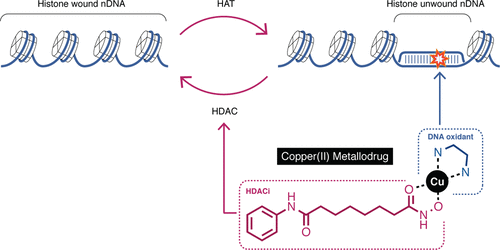当前位置:
X-MOL 学术
›
Mol. Pharmaceutics
›
论文详情
Our official English website, www.x-mol.net, welcomes your feedback! (Note: you will need to create a separate account there.)
Innovative DNA-Targeted Metallo-prodrug Strategy Combining Histone Deacetylase Inhibition with Oxidative Stress
Molecular Pharmaceutics ( IF 4.9 ) Pub Date : 2018-09-07 00:00:00 , DOI: 10.1021/acs.molpharmaceut.8b00652 Tadhg J. P. McGivern 1, 2 , Creina Slator 2 , Andrew Kellett 2 , Celine J. Marmion 1
Molecular Pharmaceutics ( IF 4.9 ) Pub Date : 2018-09-07 00:00:00 , DOI: 10.1021/acs.molpharmaceut.8b00652 Tadhg J. P. McGivern 1, 2 , Creina Slator 2 , Andrew Kellett 2 , Celine J. Marmion 1
Affiliation

|
Cancer remains a global health challenge. There is an urgent need to develop innovative therapeutics that can overcome the shortcomings of existing cancer therapies. DNA enzymes involved in nucleic acid compaction and organization are an attractive cancer drug target for therapeutic exploitation. In this work, a family of Cu(II) prodrugs containing suberoylanilide hydroxamic acid (SAHA), a well-established histone deacetylase inhibitor (HDACi) and clinically approved cancer drug, and phenanthrene ligands as DNA intercalative components have been rationally developed. The complexes, of general formula [Cu(SAHA–1H)(N,N′-phenanthrene)]+, exhibit excellent DNA recognition with binding affinity of lead agents in the order of ∼107 M(bp)−1. Biophysical studies involving nucleic acid polymers indicate intercalative binding at both adenine-thymine (A-T) and guanine-cytosine (G-C) rich sequences but thermodynamically stable interactions are favored in G-C tracts. The complexes mediate DNA damage by producing reactive oxygen species (ROS) with spin trapping experiments showing that superoxide, the hydroxyl radical, and hydrogen peroxide play critical roles in strand scission. The agents were found to have promising antiproliferative effects against a panel of epithelial cancers, and in two representative cell lines possessing mutated p53 (SK-OV-3 and DU145), enhanced cytotoxicity was observed. Significantly, mechanistic experiments with the most promising candidates revealed HDAC inhibition activity was achieved over a shorter time frame as compared to clinical standards with DNA damage-response markers identifying upregulation of both DNA synthesis and nucleotide excision repair (NER) pathways. Finally, confocal imaging and gene expression analysis show this metallodrug class exerts cytotoxic activity predominantly through an apoptotic pathway.
中文翻译:

结合组蛋白脱乙酰基酶抑制作用和氧化应激的创新DNA靶向金属前药策略
癌症仍然是全球健康挑战。迫切需要开发能够克服现有癌症疗法的缺点的创新疗法。涉及核酸紧缩和组织的DNA酶是治疗开发中有吸引力的抗癌药物靶标。在这项工作中,已经合理地开发了含有辛二酰氨基苯胺异羟肟酸(SAHA),成熟的组蛋白脱乙酰基酶抑制剂(HDACi)和临床批准的抗癌药以及菲配体作为DNA插入组分的Cu(II)前药家族。通式为[Cu(SAHA –1H)(N,N'-菲)] +的配合物表现出优异的DNA识别能力,与前导剂的结合亲和力约为107 M(bp)-1。涉及核酸聚合物的生物物理研究表明,在富含腺嘌呤-胸腺嘧啶(AT)和鸟嘌呤-胞嘧啶(GC)的序列上均具有插入结合,但在GC片段中有利于热力学稳定的相互作用。该复合物通过产生自旋陷阱实验产生活性氧(ROS)来介导DNA损伤,结果表明超氧化物,羟基自由基和过氧化氢在断链中起关键作用。发现这些试剂对一组上皮癌具有有希望的抗增殖作用,并且在具有突变的p53的两个代表性细胞系(SK-OV-3和DU145)中,观察到了增强的细胞毒性。显着地,与最有希望的候选者进行的机械实验显示,与具有DNA损伤反应标记物的临床标准相比,HDAC抑制活性在更短的时间内得以实现,DNA损伤反应标记物可识别DNA合成和核苷酸切除修复(NER)途径的上调。最后,共聚焦成像和基因表达分析表明,这种金属药物主要通过细胞凋亡途径发挥细胞毒性作用。
更新日期:2018-09-07
中文翻译:

结合组蛋白脱乙酰基酶抑制作用和氧化应激的创新DNA靶向金属前药策略
癌症仍然是全球健康挑战。迫切需要开发能够克服现有癌症疗法的缺点的创新疗法。涉及核酸紧缩和组织的DNA酶是治疗开发中有吸引力的抗癌药物靶标。在这项工作中,已经合理地开发了含有辛二酰氨基苯胺异羟肟酸(SAHA),成熟的组蛋白脱乙酰基酶抑制剂(HDACi)和临床批准的抗癌药以及菲配体作为DNA插入组分的Cu(II)前药家族。通式为[Cu(SAHA –1H)(N,N'-菲)] +的配合物表现出优异的DNA识别能力,与前导剂的结合亲和力约为107 M(bp)-1。涉及核酸聚合物的生物物理研究表明,在富含腺嘌呤-胸腺嘧啶(AT)和鸟嘌呤-胞嘧啶(GC)的序列上均具有插入结合,但在GC片段中有利于热力学稳定的相互作用。该复合物通过产生自旋陷阱实验产生活性氧(ROS)来介导DNA损伤,结果表明超氧化物,羟基自由基和过氧化氢在断链中起关键作用。发现这些试剂对一组上皮癌具有有希望的抗增殖作用,并且在具有突变的p53的两个代表性细胞系(SK-OV-3和DU145)中,观察到了增强的细胞毒性。显着地,与最有希望的候选者进行的机械实验显示,与具有DNA损伤反应标记物的临床标准相比,HDAC抑制活性在更短的时间内得以实现,DNA损伤反应标记物可识别DNA合成和核苷酸切除修复(NER)途径的上调。最后,共聚焦成像和基因表达分析表明,这种金属药物主要通过细胞凋亡途径发挥细胞毒性作用。


























 京公网安备 11010802027423号
京公网安备 11010802027423号